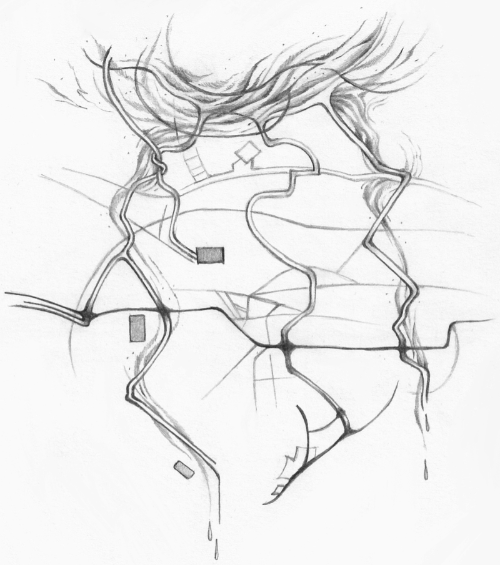_780x780.png)
Water Uninterrupted
Restoring India’s natural creeks to curb urban floods
E Jayashree Kurup
Shailendra Singh, an engineer with premium educational tags to his name, works in the city of his dreams — Gurgaon, or Gurugram as it is now called. Studying in Meerut, about 100 km away, he was fascinated by the glitter and shine of the glass and steel information technology hub. So, during college placements, he opted for a multinational IT company in Gurugram over the large Indian semiconductor company that offered him a job in a Tier 2 city in the hinterland.
With his new six-figure salary, Shailendra never thought twice about purchasing a premium apartment worth over Rs 35 crore (equivalent to USD 4.5 million) on Golf Course Road, directly overlooking the DLF Golf and Country Club. He now lived just 5 km (3.1 miles) from his place of work, the DLF Cyber City with 12 million square feet of premium commercial and retail space. The twenty minute daily commute in his plush BMW seemed the culmination of his dreams. Or so he thought — until monsoon 2018, when one big squall hit the city with over 128 millimetres of rain in just under five hours. Shailendra looked on in dismay as the streets that earlier spelt the promise of a good life now turned into a churning river that he had to negotiate on the road. Never before had the five kilometres home seemed so long. In another part of the city, the rain waters flooded a street and a labourer was electrocuted, Shailendra’s colleague later told him.
Twitter was buzzing with the rainfall of a century, blaming climate change and inadequate infrastructure in the city. There were detailed stories about recent peak rainfall events and ways in which flooding could have been tackled. Everything his education taught him about hydrological channels flashed before Shailendra’s eyes. Like everyone else, he blamed the government. He could see his domestic help and driver struggling to reach their workplace in the raging waters. They had to rely entirely on shared public transport. In some cases, their shanties were washed away or broken. Shailendra thought about how even citizens like him, who paid their taxes, who brought wealth to the city and considered themselves an asset to the economy, were no better off now.
.jpg)
About 3,000 km away is Nitin Kingale, Shailendra’s college batch mate, who was placed in a premium multinational working in AutoCAD in Bengaluru, often referred to as the Silicon Valley of India. Like his friend Shailendra, Nitin lives in a super luxury apartment just a few kilometres away from the premium IT hub on the Outer Ring Road (ORR), near Bellandur. Coming from a small city in the hinterland, he wanted his lake view, a luxury that was fast disappearing in Bengaluru.
In the sixteenth century, the visionary ruler Kempegowda started work on a network of lakes in his kingdom, which was added to by subsequent rulers. These lakes, over the centuries, were used for irrigation, water supply, and fishing. Of the over 1,000 lakes in Bengaluru, just over 200 remain now. As the city grew, the colonial rulers planned urban growth, with sewage from the urban areas discharged into many lakes and interlinking channels, a practice that continued until recently.
In 2018, Nitin’s apartment overlooked Bellandur, the city’s largest lake. It was now polluted by industrial effluents and domestic sewage that flowed untreated into the waters. But he had hoped that the scrutiny of the National Green Tribunal (NGT), which had passed several orders to preserve the lake and bring the water back to its clean condition, would work. Even during the 2020 pandemic lockdown, the lake was drained by the city authorities. The bed was then cleaned and water refilled. Surely things would be better!
But monsoon 2022 not only destroyed that illusion but also forced him to wade through murky water to navigate the immensely flooded streets where the richest and poorest struggled alike to simply remain afloat in the 125 millimetre rain that fell in twenty-four hours. Climate change was washing away his dreams as water flowed down the main streets and flooded offices and homes alike. He too blamed the government. His teams use CAD drawings to design the most advanced districts in the world. What is the use of paying taxes if citizens’ lives are not made any easier, he thought.
Citizens Seek Solutions
Change, they say, happens in many ways. Shailendra’s attitude of blaming the government changed when he met a team of local volunteers in Gurugram. They were all experts who said they wanted to be part of the solution. Many of them had worked since 2010 onwards to revive 153.7 acres of land that had been freed after the Supreme Court’s mining ban in 2002. The ban was enforced only in 2009 and was being eyed by various land sharks because of the premium location of the land and its future potential.
The citizen group, IAmGurgaon1, worked with the city administration and a team of botanists and environmentalists to start a people’s movement. They encouraged citizens and corporate groups to plant 160 native species of plants in the degraded land to convert it into a biodiversity park. It was ecologically restored with semi-arid vegetation to suit the local climate. Today it draws over 185 species of birds and animals such as nilgai, monitor lizards, civets, and jackals. More importantly, the soft earth allows water to be trapped within the park. One of the abandoned mines has now become a pond.
The second venture of the group directly impacted Singh. Gurugram is in the foothills of one of the oldest mountain ranges in the world, the Aravallis. Whenever it rains, the water flows down four natural creeks2 to the pondage areas. These creeks have long since been blocked with large multi-storey apartments such as the one Shailendra lived in. But water finds its own way. If blocked, the channel would flood whatever was in its path. “Gurgaon has enough greens to absorb the overflow, if we would only open channels to allow the water to percolate into the ground,” says Latika Thukral. Latika was once a top-notch Citibank professional who now works with corporates to spend Corporate Social Responsibility (CSR) funds towards repairing the damage that four decades of rapid unplanned urbanisation has done to the city.

Working around the natural creeks in the city, Latika and her team of volunteers have collaborated with city authorities to create a series of bunds, natural waterways to slow down surface runoff and enhance aquifer recharging. Shailendra learnt much from Latika about channelling the excess water that is now on the streets to the low-lying protected Aravali greens. When created along a natural creek, not only do the bunds prevent flooding but they also create shaded safe zones for people to walk on during drier days. The addition of natural vegetation created more water traps and allowed the rain water to flow uninterrupted to safe zones. With his corporate connections, Shailendra realised that he could become part of the team that could motivate companies to spend CSR funds towards a cause that would enhance the quality of life of their workforce while also enhancing employee productivity, even on rainy days.
It helped that the Chief Executive Officer of the Gurugram Metropolitan Development Authority (GMDA), Sudhir Rajpal, believed in working with citizens to solve the problems of the city. Shailendra now volunteers on an ongoing basis with I’m Gurgaon and has also become part of the commissioner’s citizen team that works on finding solutions to climate change in the city.
The genesis of the problem, Rajpal’s team found, was that of the 118 naturally-formed bunds that had once carried the water from the Aravallis across the city to pondage areas, just thirty had survived into modern times. A 2017 survey by the city administration showed that, of the sixty-three bunds created during British rule in the eighteenth and nineteenth centuries, only four survived.
But today, the civic administration, along with I’m Gurgaon and several corporate houses, has freed a bund from the eastern part of the city. The channel runs along densely populated residential areas close to the city centre. The civic administration and I’m Gurgaon cleared encroachments, planted native trees and bushes, and created a natural walkway for pedestrians alongside the cleaned water channel in the heart of the city. Not only did this slow down the flow of surface water but reduced instances of flooding along the bund.
When created alongside a natural creek, not only do the bunds prevent flooding, but they also create shaded safe zones for people to walk on, on the non rainy days. The addition of natural vegetation created more water traps and allowed the rain water to flow uninterrupted to safe zones. While working on the details of the project, Latika had worked with a group of domestic workers, who earlier used to walk alongside the choked channel on their way to work. Today, as they walk along the restored walkway, they look on her as their benefactor. It is as much a morning exercise walkway for the rich in the condominiums nearby as a safe short route to work for the domestic workers. The solutions benefited the rich and the poor.
CEO Rajpal’s administration attributes urban floods to a host of reasons:
Rapid urbanisation of cities
Encroachment by land grabbers of natural ponds and creeks
Lack of regular desilting of drains
Non connectivity of surface drains with the master drain
Sewage and waste disposal in drains
Reviving Lakes
In Bengaluru, meanwhile, Nitin’s quest for solutions led him to a committed group of environmentalists, many of whom forsook well-paying government or corporate careers to work on restoring former lakes and bodies of water. He met S Viswanath, a former government official who discovered that reviving old surface wells was a way of capturing surface runoff to the extent that it could replace the need for municipal water supplies. His solutions involved the local well-digger community, who located and revived the wells in the flood spots. His other inspiration came from Anand Malligavad, who gave up a corporate career to revive twenty-five lakes in Bengaluru in five years. Blessed with rainfall in varying quantities across eight months, the city’s rocky base makes it easier to store water in large ponds and wells rather than trying to only recharge underground aquifers, as in the case of Gurugram.
As he delved deeper, Nitin joined a team of researcher-influencers who used meticulous study of data to drive change on the ground. His knowledge of contour maps made him a valuable team member. Many people sold their apartments when the floods entered premium residential and commercial property in Bellandur and North Bangalore. Nitin and his team, on the other hand, drew up satellite maps that would help identify the old lake networks and ancient overflow channels or rajakaluves, that used the city’s natural gradient to allow flow from one to the other.
Wherever possible, they met fellow activists such as Usha Rajagopalan, who led a citizen movement to rejuvenate the Puttenahalli lake and worked with the city administration to form the Puttenahalli Lake Improvement Trust. But a one time revival does not mean a permanent solution. In many cases, government agencies created the problems. A clear indication of the presence of sewage in the water is when the lake gets overgrown with plants such as water hyacinths. Rajagopalan’s team found that after the revival of the lakes, and even after clean water had been restored, one government department channelled sewage back to the lake through an underground channel. And the process began all over again. Clearly, citizen activists could not lower their guard until efficient water management became a norm.

Urban Floods
Nitin and Shailendra’s problems were by no means exceptions to the rule. City after city in urban India has been facing severe flooding over the past couple of decades. The wake-up call came to India in Mumbai in 2005, when over 944 millimetres of rain fell on the city in a single spell, causing floods that left about 2,000 people dead. The water that should have drained into the mangroves and the Mithi river could not, as the river was choked with plastics and debris. The mangroves had been systematically destroyed. These factors, combined with the fact that the sea water had not receded since high tide, left the city inundated.
The 2015 Chennai floods resulted in a similar story. In this coastal city, which sees peak monsoon rains in November, wetlands have been under threat because of urbanisation. In addition, the arterial Adyar river had been choked with sewage and garbage. Water levels in the reservoirs rose in the wake of intense rainfall during cyclone Nivar’s landfall. The city authorities then decided to release 1,000 to 5,000 cusecs (7480 to 37,400 gallons/sec) water from the Chembarambakkam reservoir to the Adyar river. The already choked river burst its banks. The resultant floods are estimated to have caused damages worth over USD 3.5 billion, according to a Munich RE assessment. The fact that wetlands, lakes, tanks, and ponds as well as rivers had been eaten into and polluted by urbanisation was brought into sharp focus.
In September 2021, Bengaluru received a record 131.6 millimetres of rain in twenty-four hours. The city’s lakes, including the Nagawara lake in Hebbal, overflowed as they were designed to do. However, with encroachments by builders on the centuries-old irrigation channels, the water flowed into the tech parks on Outer Ring Road, creating mayhem for days. The city authorities, the Bruhat Bengaluru Mahanagara Palike (BBMP) complained that the fault was that of the developers who had encroached on the Rajakaluves. A year later, it was the turn of Bellandur, also on the Outer Ring Road in East Bengaluru, to face the wrath of the flood waters. This time the Bellandur, Halleyakanahalli, and Varthur lakes overflowed.
City after city has seen the same results following high-intensity rainfall because the sanctity of nearby bodies of water had not been respected. It has led to numerous unproductive workdays, destruction of property and infrastructure, and loss of countless lives.

Shared Learning
If the problems and their triggers were similar across cities, solutions too can be replicable nationally, or even internationally. The federal government had been allocating resources to clean the river Ganga, which traverses the length of the mountains and plains of North India and flows across five states. Like the creeks and lakes that Shailendra and Nitin have been struggling to revive, preserve, and restore, urban rivers too were systematically polluted. The drainage channels in rapidly urbanising India started throwing untreated sewage into them from colonial times onwards. The National Mission for Clean Ganga (NMCG), a governmental trust incorporated for cleaning one of the most iconic rivers in North India, identified a host of problems. It used a public-private people's partnership, with alliances to premium technology institutes such as the Indian Institute of Technology Kanpur (IIT-Kanpur), to find modern solutions. It has resulted in a cleaner Ganga over five years. This time, however, it was not by banning leather workers and other polluters, but by creating new systems that removed pollution while keeping productive activities intact.
The learnings and takeaways formed the first empirical study by the NMCG into the many facets of cleaning urban rivers. It has now morphed into the River Cities Alliance that allows every river city to take up the stretch of the river that runs through it, for rejuvenation and cleaning. City managers, a host of citizen groups, premier universities like IIT-Kanpur, all worked towards finding holistic, long-term solutions. In many cases, it just involved joining broken links, and in others, re-engineering solutions. This resulted in the Climate Smart Cities Assessment Framework (CSCAF). CSCAF forms a vital tool for pressure groups such as Shailendra and Nitin to use as reference documents. The story of how the river was cleaned was documented by its then mission directors in the book Ganga: Reimagining, Rejuvenating, Reconnecting. It has become resource material for city managements and citizen activists to use as reference material.
Both Shailendra and Nitin realised the root of the problem: that covering up natural creeks stemmed from the 1980s and 1990s when rainfall was low. But rainfall has intensified globally as a result of climate change and global warming in the two decades of the twenty-first century. For cities that had originally designed water channels to cope with about 55 millimetres of rainfall per day in the monsoons, the norm has gradually inched up to about 100 to 130 millimetres, all happening sometimes within just a couple of hours. Even the best designed systems currently do not have the carrying capacity. While water created havoc on the surface, very little seeped into the ground to recharge aquifers where water levels had already fallen due to over-use and extraction.
With less strain on the drainage systems during the lower rainfall years of 1980s and 1990s, the unplanned growth of dwelling units to accommodate the large number of migrants resulted in the under utilised drainage networks becoming the first point of weakness. They were punctured in many places, and sewage from unplanned areas flowed into them. While rainfall was scant, it went unaddressed. Sewage, unlike rainwater, clogged the networks and reduced carrying capacity significantly. Latika, Shailendra, Nitin, and a host of other pressure groups have been helping city managers identify the punctured points and realign the sewage channels to accommodate the extra flow. Government agencies, too, have taken up projects to manage water, along with solid and liquid waste, to convert them from a problem to a solution. But decentralised and often innovative solutions are additionally required to solve these significant legacy problems.
There are many takeaways from quests such as that of Shailendra and Nitin. Replanning the entire network in a living city is extremely challenging. But once documented, Shailendra found the Gurgaon administration was quite open to citizen’s suggestions to solve problems locally. Small interventions could help avert potential disasters. In the same 2018 floods that brought Shailendra so much distress, a labourer died of electrocution in a waterlogged street. Moved by the magnitude of the disaster, one of Shailendra’s fellow citizens worked with the municipal councillor, along with concerned citizens from the shanties, to solve the problem. They worked with municipal engineers to create a sewage line diversion to accommodate the waste that earlier flowed into a drainage channel from what was once a small urban village. Once the sewage load was off the drainage network, the storm water channel became more efficient. The historic, rain-induced water logging on the roads adjoining the village reduced considerably, and Shailendra and his friends vowed to reduce the chances of another such loss of life.
Urban floods cannot be a government’s responsibility alone. The solutions are as complex as the problems themselves. Unless the marginalised are accommodated into the formal infrastructure, the water management problems will persist. Many nongovernmental agencies (NGOs) work with marginalised citizens, trying to fit those living in shanties and unplanned spaces within the city into the managed networks. Ultimately, the micro-planning solutions here could solve major, city-level problems.
Working Solutions
Citizens have been equally responsible for the degradation of urban water, so they need to take an active interest in the restoration of natural hydrological channels.
Cities need to create soft surfaces for water to seep into the ground and recharge the natural aquifers. Instead of allowing precious water to flow away uninterrupted, it is important to lead the rain water to creeks, bunds, lakes, ponds, and wells to trap as much as possible.
As more and more citizens cover soft top ground with stone or concrete within their residential areas, surface runoff increases and flows rapidly from private enclaves to the main streets and roads, making it the city’s problem. In many parts of the United States, and in some European nations, this could attract concretisation taxes, which the city levies on citizens to manage that excess water. Alternatively, citizens can be incentivised to become part of the solution by opening up small channels on their own property to create water harvesting structures that collect and manage that water at the level of individual units. Water is a precious resource and needs to be treated as such.
Gurgaon has now created a list of actions that the city and its citizens must take, including reviving lakes, ponds, and creeks, lowering the green belt to soak up the runoff water, and regular de-silting of drains. This kind of action plan must quickly get off the ground in all major cities. Hydrological education needs to be incorporated in architectural and urban planning curricula across the country.
Bands of citizens like Shailendra and Nitin, who are well-resourced and have more political sway should work with those of the working class who are at much higher risk when flooding hits their cities. When governments and citizens work together, everyone – from those marginalised, like the labourer who lost his life due to flooding, and the well-heeled lot working in corporate offices – can benefit.
With a multi-pronged approach, Nitin Kingale and Shailendra Singh’s solutions do not remain exclusionist. They include the lives of their domestic and office workers and the informal workers across the city. And Shailendra and Nitin may well become part of the solution, and eventually get to live the dream life they had envisioned. At the same time, instead of the actions of the haves poorly impacting the lives of the have-nots, and vice versa, they may find that water can jointly become their friend and not remain their foe.



%20(3)_700x350.jpg)


_700x700.png)








